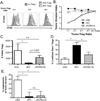Regulatory T cells require TCR signaling for their suppressive function
- PMID: 25821220
- PMCID: PMC4402269
- DOI: 10.4049/jimmunol.1402384
Regulatory T cells require TCR signaling for their suppressive function
Abstract
Regulatory T cells (Tregs) are a subset of CD4(+) T cells that maintain immune tolerance in part by their ability to inhibit the proliferation of conventional CD4(+) T cells (Tconvs). The role of the TCR and the downstream signaling pathways required for this suppressive function of Tregs are not fully understood. To yield insight into how TCR-mediated signals influence Treg suppressive function, we assessed the ability of Tregs with altered TCR-mediated signaling capacity to inhibit Tconv proliferation. Mature Tregs deficient in Src homology 2 domain containing leukocyte protein of 76 kDa (SLP-76), an adaptor protein that nucleates the proximal signaling complex downstream of the TCR, were unable to inhibit Tconv proliferation, suggesting that TCR signaling is required for Treg suppressive function. Moreover, Tregs with defective phospholipase C γ (PLCγ) activation due to a Y145F mutation of SLP-76 were also defective in their suppressive function. Conversely, enhancement of diacylglycerol-mediated signaling downstream of PLCγ by genetic ablation of a negative regulator of diacylglycerol kinase ζ increased the suppressive ability of Tregs. Because SLP-76 is also important for integrin activation and signaling, we tested the role of integrin activation in Treg-mediated suppression. Tregs lacking the adaptor proteins adhesion and degranulation promoting adapter protein or CT10 regulator of kinase/CT10 regulator of kinase-like, which are required for TCR-mediated integrin activation, inhibited Tconv proliferation to a similar extent as wild-type Tregs. Together, these data suggest that TCR-mediated PLCγ activation, but not integrin activation, is required for Tregs to inhibit Tconv proliferation.
Copyright © 2015 by The American Association of Immunologists, Inc.
Conflict of interest statement
The authors declare no conflicts of interest.
Figures





References
-
- Brunkow ME, Jeffery EW, Hjerrild KA, Paeper B, Clark LB, Yasayko SA, Wilkinson JE, Galas D, Ziegler SF, Ramsdell F. Disruption of a new forkhead/winged-helix protein, scurfin, results in the fatal lymphoproliferative disorder of the scurfy mouse. Nat Genet. 2001;27:68–73. - PubMed
-
- Kim JM, Rasmussen JP, Rudensky AY. Regulatory T cells prevent catastrophic autoimmunity throughout the lifespan of mice. Nature immunology. 2007;8:191–197. - PubMed
-
- Sakaguchi S, Sakaguchi N, Asano M, Itoh M, Toda M. Immunologic self-tolerance maintained by activated T cells expressing IL-2 receptor alpha-chains (CD25). Breakdown of a single mechanism of self-tolerance causes various autoimmune diseases. Journal of immunology. 1995;155:1151–1164. - PubMed
-
- Belkaid Y, Rouse BT. Natural regulatory T cells in infectious disease. Nature immunology. 2005;6:353–360. - PubMed
Publication types
MeSH terms
Substances
Grants and funding
LinkOut - more resources
Full Text Sources
Other Literature Sources
Molecular Biology Databases
Research Materials
Miscellaneous

